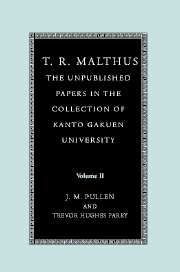Book contents
- Frontmatter
- Contents
- Preface
- Editorial procedures
- List of abbreviations
- Acknowledgements
- 1 Sermons
- 2 Malthus' diary of a tour of the Lake District
- 3 Bullion trade transactions
- 4 An essay on foreign trade
- 5 Essays and notes on Charles I and Mary, Queen of Scots
- 6 Questions and answers on early European history
- 7 Harriet Malthus' diary of a family tour of Scotland in 1826
- 8 Letters to Harriet Malthus from her mother, Catherine Eckersall
- 9 Eight brief miscellaneous items
- Appendix A Additional material not reproduced
- Appendix B Letters to David Ricardo
- Bibliography
- Kanto Gakuen Catalogue
- Index
6 - Questions and answers on early European history
Published online by Cambridge University Press: 23 December 2009
- Frontmatter
- Contents
- Preface
- Editorial procedures
- List of abbreviations
- Acknowledgements
- 1 Sermons
- 2 Malthus' diary of a tour of the Lake District
- 3 Bullion trade transactions
- 4 An essay on foreign trade
- 5 Essays and notes on Charles I and Mary, Queen of Scots
- 6 Questions and answers on early European history
- 7 Harriet Malthus' diary of a family tour of Scotland in 1826
- 8 Letters to Harriet Malthus from her mother, Catherine Eckersall
- 9 Eight brief miscellaneous items
- Appendix A Additional material not reproduced
- Appendix B Letters to David Ricardo
- Bibliography
- Kanto Gakuen Catalogue
- Index
Summary
INTRODUCTION
This is a book of 76 pages of manuscript dealing with European history from the fifth to the tenth century. The contents are divided into four sections, entitled ‘Lecture i’, ‘Lecture ii’, ‘L iii’ and ‘L iv’, but the material is in the form of questions and brief answers, rather than full-length lectures. In the original, the questions are written on the versos and their answers on the rectos (except in a few cases where the answers spill over into spare spaces on the versos); but for simplicity of presentation each answer in this transcription is placed immediately after its corresponding question, with the question in bold type.
The questions in MS are numbered, although as noted below the numbering sequence is broken at one point. There are 84 questions in all – 20 in the first lecture, 22 in the second, 22 in the third (incorrectly numbered ‘21’ in MS), and 20 in the fourth. All of the questions have answers. In some cases the answers are in the form of brief notes and incomplete sentences, but generally they consist of formal statements, probably intended for lecture-room dictation. The method of presentation is similar to that used by Malthus in his lectures on political economy as seen in the Inverarity Manuscript (Pullen 1981; Hashimoto 1988), although the answers are expressed more fully and in a more formal style in these history lectures than in the political economy lectures.
- Type
- Chapter
- Information
- Publisher: Cambridge University PressPrint publication year: 2004



